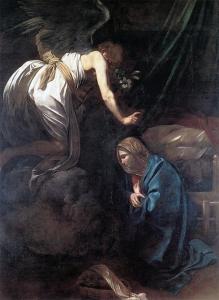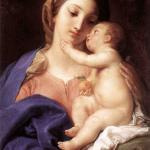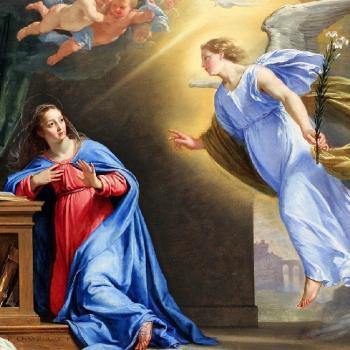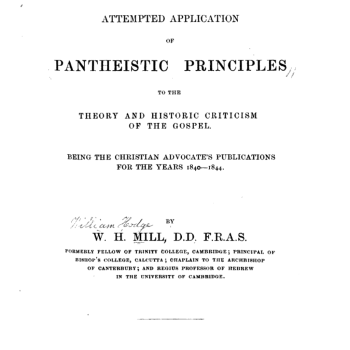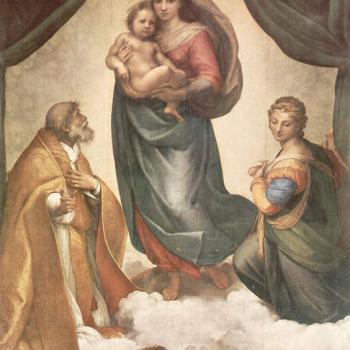The Evangelical Lutheran Synod has all of 19,394 members. In a little tract called “Jesus’ Brothers” it was stated:
Of course, the reason why Rome feels compelled to preserve Mary as “semper virgine” is to maintain, what they say, is her status as “all holy and free from every stain of sin.” Apparently it was felt that if Mary would have had normal sexual relations with sinful Joseph after Jesus’ birth, this would destroy their doctrine of Mariolatry.
The tract even noted that Martin Luther believed in Mary’s perpetual virginity, but that he supposedly did so due to an illegitimate reason:
Due to the influence of the Roman Catholic Church in wanting to maintain Mary as “semper virgine” . . . many theologians, including Luther, opted for the meaning “cousins”.
It couldn’t possibly be, for these people, that both Luther and Catholicism offered biblical reasons (agree or disagree with them) for their views.
I never cease to be amazed at the arrogant and condescending ignorance of some of our Protestant brothers and sisters, who take it upon themselves to slander and misrepresent our teachings about the Blessed Virgin Mary. This ridiculous paragraph (first one above) presupposes (without evidence or proof) four falsehoods:
1) That their hypothesis is the reason that Catholics believe in the perpetual virginity of Mary.
2) That we regard proper marital sexual relations as always and necessarily “sinful.”
3) That we have no other reason besides a supposed (imaginary) antipathy to sex as universally sinful, to hold to Mary’s perpetual virginity.
4) That we wish to set Mary up as an idol in competition with God.
As usual, there is no documentation from official Catholic sources that Catholics believe such absurd things. The real reasons why we believe in the doctrine are these:
1) We think that the best interpretation of the Bible and the exegesis of relevant passages, lead to this conclusion.
2) We accept the consensus of the Church fathers (i.e., sacred, apostolic tradition) on the matter (i.e., either that these “brothers” were Jesus’ cousins or Joseph’s sons from a previous marriage: he being a widower).
3) The question isn’t sinfulness; rather, it is a matter of “fittingness“. Catholics and Orthodox and also all the early Protestant leaders and a considerable number of Protestants throughout history who weren’t or aren’t theologically liberal have held to this. And this factor is based on abundant and explicit biblical background thought as well.
The following are what I believe to be the best biblical arguments (yes, there actually are some good ones!), briefly explained:
1) Luke 2:41-51 describes Mary and Joseph taking Jesus to the temple at the age of twelve, for the required observance of Passover. Everyone agrees that He was the first child of Mary, so if there were up to five or more siblings, as some maintain (or even one), why is there no hint of them at all in this account? I recently wrote in-depth about this.
2) Neither Hebrew nor Aramaic have words for “cousin.” The New Testament was written in Greek, which does have such a word (sungenis), but Jesus and His disciples spoke Aramaic (a late version of Hebrew), and the Hebrew word ach is literally translated as adelphos, the literal equivalent of the English “brother.” In the Bible, it has a very wide range of meanings beyond “sibling”: just as “brother” does in English. Thus, it is routinely used in the New Testament to describe cousins or kinsmen, etc.
3) Jesus Himself uses “brethren” (adelphos) in the non-sibling sense. In Matthew 23:8 (cf. 12:49-50), He calls, for example, the “crowds” and His “disciples” (23:1) “brethren.” In other words, they are each other’s “brothers”: the brotherhood of Christians.
4) In comparing Matthew 27:56, Mark 15:40, and John 19:25, we find that James and Joseph (mentioned in Mt 13:55 with Simon and Jude as Jesus’ “brothers”) are the sons of Mary, wife of Clopas. This other Mary (Mt 27:61; 28:1) is called the Blessed Virgin Mary’s adelphe in John 19:25. Assuming that there are not two women named “Mary” in one family, this usage apparently means “cousin” or more distant relative. Matthew 13:55-56 and Mark 6:3 mention Simon, Jude and “sisters” along with James and Joseph, calling all adelphoi. The most plausible interpretation of all this related data is a use of adelphos as “cousins” (or possibly, step-brothers) rather than “siblings.” We know for sure, from the above information, that James and Joseph were not Jesus’ siblings.
It’s not mere special pleading to argue in this fashion, nor an alleged “desperation” of Catholics who supposedly “read into” the texts their prior belief in the dogma of perpetual virginity. Plenty of Protestant exegesis and scholarship confirms these views: especially in older commentaries. For example, the prominent 19th century Commentary on the Whole Bible, by Jamieson, Fausset & Brown, states, regarding Matthew 13:55 (my italics added):
An exceedingly difficult question here arises – What were these “brethren” and “sisters” to Jesus? Were they, First, His full brothers and sisters? or, Secondly, Were they His step-brothers and step-sisters, children of Joseph by a former marriage? or, Thirdly, Were they His cousins, according to a common way of speaking among the Jews respecting persons of collateral descent? On this subject an immense deal has been written, nor are opinions yet by any means agreed . . . In addition to other objections, many of the best interpreters, . . . prefer the third opinion. . . Thus dubiously we prefer to leave this vexed question, encompassed as it is with difficulties.
5) The Blessed Virgin Mary is committed to the care of the Apostle John by Jesus from the Cross (John 19:26-27). Jesus certainly wouldn’t have done this if He had brothers (all of whom would have been younger than He was).
6) Jude is called the Lord’s “brother” in Matthew 13:55 and Mark 6:3. If this is the same Jude who wrote the epistle bearing that name (as many think), he calls himself “a servant of Jesus Christ and brother of James” (Jude 1:1). Now, suppose for a moment that he was Jesus’ blood brother. In that case, he refrains from referring to himself as the Lord’s own sibling (while we are told that such a phraseology occurs several times in the New Testament, referring to a sibling relationship) and chooses instead to identify himself as James‘ brother. This is far too strange and implausible to believe. Moreover, James also refrains from calling himself Jesus’ brother, in his epistle (James 1:1: “servant of God and of the Lord Jesus Christ”): even though St. Paul calls him “the Lord’s brother” (Gal 1:19).
It’s true that Scripture doesn’t come right out and explicitly state that Mary was a perpetual virgin. But nothing in Scripture contradicts that notion, and — to say the same thing another way — nothing in the perpetual virginity doctrine contradicts Scripture.
The argument from “fittingness” is more subtle and less easy to be grasped. But it can be fully defended from Scripture as well. I have made a form of this argument derived from the notion of Mary as “holy ground”:
A priest who was helping a Baptist woman to understand the perpetual virginity of Mary became a bit frustrated, finally blurting out: “God Himself was in Mary’s womb!” In a moment of illumination or grace or inspiration, the woman understood, thinking: “Take off your shoes, for this is holy ground.” The many relevant biblical analogies took hold.
We observe in Holy Scripture, for instance, Uzziah, who died when he touched the ark of the covenant, which was arguably the holiest object in the Old Testament (and Mary is the new ark of the covenant, according to the Bible), even though he was only trying to prevent it from falling:
2 Samuel 6:6-7 (RSV) And when they came to the threshing floor of Nacon, Uzzah put out his hand to the ark of God and took hold of it, for the oxen stumbled. [7] And the anger of the LORD was kindled against Uzzah; and God smote him there because he put forth his hand to the ark; and he died there beside the ark of God.
Others died by merely looking inside the ark:
1 Samuel 6:19 And he slew some of the men of Beth-she’mesh, because they looked into the ark of the LORD; he slew seventy men of them, and the people mourned because the LORD had made a great slaughter among the people. (cf. Ex 33:20).
When God was present in a special way on Mount Sinai, at the time Moses received the Ten Commandments (Exodus, chapters 19 and 20), the people were warned not to even touch the mountain or its border, lest they die:
Exodus 19:11-12 and be ready by the third day; for on the third day the LORD will come down upon Mount Sinai in the sight of all the people. [12] And you shall set bounds for the people round about, saying, `Take heed that you do not go up into the mountain or touch the border of it; whoever touches the mountain shall be put to death;
This included even animals (19:13). I submit that this has implications for the propriety of Mary carrying God in her womb for nine months (and no one else). Without going into unnecessary detail, it also follows analogically, and from pious reflection, I think, that Mary’s perpetual virginity is fitting and proper (though not literally necessary) by the nature of the relationship of a holy God and man.
The Blessed Virgin Mary became, in effect, the New Holy of Holies, where God specially resides. But in the case of Mary, God is more present than He ever was in the tabernacle and temple, because now He is there physically, as a man, as well. Mary is the ark of the new covenant (as the Church fathers called her) and Mother of God (the Son).
The denial of Mary’s perpetual virginity (which was a radical innovation of the last 200-250 years, and not the view of the Protestant founders) exhibits an inadequate understanding of holy places and things. Consecrated persons and places are “set aside” for God’s holy purposes.
Someone stated in a Facebook discussion that Catholic beliefs about Mary would mean she wasn’t a “normal wife.” I replied that Mary was anything but a “normal” Jewish wife in the first place. She was suddenly “with child” miraculously by the Holy Spirit, and gave birth to Jesus: God the Son.
Some things can be so entirely appropriate that they almost approach necessity: not strictly “logically” but perhaps “spiritually.” Even the crucifixion (and perhaps the incarnation itself) were not strictly necessary (God could have simply declared those people saved who would have been saved by Jesus’ death on the cross), but they are sublimely important in the overall scheme of things.
God chose to save mankind by means of them. The virgin birth and perpetual virginity were the means that God chose to create the appropriate context in which the incarnation occurred.
In Catholic thinking, and the ancient apostolic tradition, Mary’s perpetual virginity is a protection, so to speak, of the miraculous nature of the incarnation and Jesus’ birth. It’s a Christocentric doctrine: just as all Marian doctrines are.
But so many critics are almost obsessed with unfairly blasting the Catholic Church for supposedly raising Mary to an idolatrous state, that they miss the fundamental reason for Marian beliefs: to exalt and focus on our Lord Jesus Christ.
As to whether the Catholic Church is against moral, marital sexuality: that is simply a falsehood. We never teach that anywhere, and in fact, we regard marriage as a sacrament, which means that it gives further grace to the married couple.
As to whether we raise Mary to the level of God, or idolize her and place her in competition with God, that’s simply false, too. Those who claim this are duty-bound in honesty to prove that we (as a Christian communion) believe this garbage, from our official documents. They can’t do so, and so they don’t even attempt it. They simply assert the lie, knowing that many ignorant, gullible, or merely undereducated people will accept it without proof or evidence. I recently wrote:
If in fact Catholics believed that Mary was a “goddess” then surely the term would appear in official [magisterial] Catholic documents somewhere. But of course it does not. If Lucas [Banzoli] or any Protestant denies that, let them produce the documented evidence. “Put up or shut up!” Best wishes in that endeavor!
But this Christological heretic, Lucas Banzoli, remarkably expressed his mindless anti-Catholicism regarding Mary (analogous to the ELS tract) as follows:
I never spoke of “official magisterial documents” that declare Mary a goddess. I talked about her being treated like a goddess by most Catholics, which is quite different. . . . We don’t need a paragraph in the catechism that expressly says “Mary is a goddess and we worship her”; we need only see how it is dealt with in practice, which in no way differs at all from any heathen worshiping his gods and goddesses. . . .
In short, the Roman Church does not really write with all the letters in an “official magisterial document” that “Mary is a goddess and needs to be worshipped”, but she exalts those who refer to her, beatifies the most idolatrous beings that ever existed , recommends the reading of these idolatrous books, recognizes terrifyingly idolatrous Marian “apparitions” and does absolutely nothing to curb the immense wave of idolatry among lay Catholics who do not miss the first opportunity to prostrate themselves before a piece of wood and stone. Of course, with all this, an “official magisterial document” is not even necessary – as if drawing was needed to make things more obvious.
This is pathetic. The first rule in all apologetics is to document what a theological opponent believes, from their own words or (especially) official documents. But Banzoli is beyond all that. He has magical powers to see into the hearts of “most” Catholics who treat Mary like a “goddess”: so he says in his omniscience and infinite wisdom. By this criterion of “evidence” anyone can “prove” anything.
And so it is also with this ludicrous tract put out by ELS. Groundless, slanderous claims are made about Catholic belief without the slightest documentation. It’s a disgrace and terribly dishonest pseudo-“scholarship.”
Many more arguments about Mary’s perpetual virginity and all other aspects of Catholic Mariology can be found on my Blessed Virgin Mary web page.
***
Practical Matters: Perhaps some of my 4,000+ free online articles (the most comprehensive “one-stop” Catholic apologetics site) or fifty books have helped you (by God’s grace) to decide to become Catholic or to return to the Church, or better understand some doctrines and why we believe them.
Or you may believe my work is worthy to support for the purpose of apologetics and evangelism in general. If so, please seriously consider a much-needed financial contribution. I’m always in need of more funds: especially monthly support. “The laborer is worthy of his wages” (1 Tim 5:18, NKJV). 1 December 2021 was my 20th anniversary as a full-time Catholic apologist, and February 2022 marked the 25th anniversary of my blog.
PayPal donations are the easiest: just send to my email address: [email protected]. You’ll see the term “Catholic Used Book Service”, which is my old side-business. To learn about the different methods of contributing, including 100% tax deduction, etc., see my page: About Catholic Apologist Dave Armstrong / Donation Information. Thanks a million from the bottom of my heart!
***
Photo credit: Annunciation (1608-1610), by Caravaggio (1571-1610) [public domain / Wikimedia Commons]
***
Summary: The small Lutheran denomination Evangelical Lutheran Synod (ELS) made ridiculous claims about Jesus’ “brothers” & several supposed Catholic beliefs about same.


